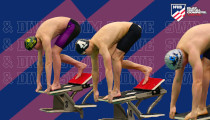High School Diving Judges scale Modified
By Don Mason on November 05, 2014 swimming & diving article PrintThe recent change in the High School Diving Judging Scale to the FINA descriptions (and scores) has prompted many discussions as teams and officials begin their season.
First, I would like to strongly recommend that as judges we all start using the adjectives used in the judging scale. By putting our thoughts into the descriptive words, Failed, Unsatisfactory, Deficient, Satisfactory, Good, Very Good, and Excellent, we can better place a dive into the correct category.
Next, the Failed, Unsatisfactory, and Deficient categories have very little change (Deficient has increased ½ point higher) while the exceptional and excellent categories have been renamed and refined at the top of the scale. Excellent describes a 10 (not necessarily a perfect dive) and Very Good replaces the adjective excellent as the second highest category. With the new scale Very Good dives receive an 8½, 9 or 9½.
The main changes fall in the Satisfactory and Good categories. Generally speaking, more dives fall into these categories than any other. The old scale condensed these categories (4½ to 7) and failed to differentiate between good divers doing average dives and average divers doing better than expected dives. It was common for a “good” diver to do a sloppy dive and receive good scores while an “ok” diver had to work extremely hard to get a good score. The new scale should fix this by stretching and raising the scores in these categories from 5 to 8.
Additionally, most coaches would agree that a dive receiving 4½’s is not satisfactory. The Satisfactory category now includes the scores 5, 5½, 6 and 6½. Almost all coaches would accept optional dives receiving scores in this satisfactory range at their championships.
We also need to understand that the adjectives we use should describe the dives. For instance an average dive, an acceptable or ok dive all are the same as satisfactory.
Average, ok, acceptable = Satisfactory.
When a dive is better than average (satisfactory) it should be scored in the Good Category (or higher) this includes scores ranging from 7 to 8. If it is slightly better a 7 is appropriate, if it is significantly better a 7½ or an 8 if it is bordering on very good. Remember that by definition, a good dive is better than average or acceptable.
If a dive is really good it is most likely in the Very Good category. Use these adjectives to describe a Very Good dive.
Outstanding, Incredible, Exceptional = Very Good
When a diver performs a dive that borders on “good” the scores may fall in both the satisfactory and good categories (i.e. 6½, 7, 7 or 7, 6½, 6½, 7, 7). This should not create any concerns or imply any judge is being unfair. However, if the scores range from 5½ to 7½ a good referee will suggest that the judges tighten up or reevaluate their scoring.
The flaw or problem we experienced with the old judging scale is that good dives were thought of as merely OK or acceptable and satisfactory dives were thought of as almost deficient. That left us with meets where excellent or exceptional dives were few and far between and most dives were scored from 4½ - 7½. This condensed range of scores led to extremely tight overall/final scores and led judges to be cautious in giving divers higher scores (especially to opposing divers). The new judging scale should create the necessary separation that has been missing in High School diving by allowing divers to receive more accurate scores and let judges differentiate dives and divers more fairly.
Another aspect I like about the new scale is in regards to the Improper hands up (or down) deduction. In the past when a diver violated this rule it was close to automatic someone would say no more than 4’s and everyone would give the dive a 4. On occasion judges would score it a 3 or 3½. With the new scale the deficient category goes up to a 4½ which allows for judges to differentiate better. A poorly skilled dive with the hands way out of place can be given a 3½, whereas a highly skilled dive with hands slightly too high or too low may be scored a 4½. If it falls in between the two a 4 is still available.
It would be a mistake to say that last year this was a good dive and the new scale is 1 point higher so I’ll give it an 8, or to over generalize and say I will just increase all the scores by one point. This would only inflate the scores and create a false sense of improvement or dive skills. Remember that there is very little or no change to the Failed, Unsatisfactory and Deficient categories while the top two categories of Very Good and Excellent are available for exceptionally well done dives. As a judge we all need to redefine the categories, use the adjectives to describe the dive and do our best to place dives into the appropriate category.
If you or another judge is having difficulty adapting to the new scale allow yourself some time to adjust. Use the change to increase conversations regarding judging and work together to help everyone understand the new categories. Remember that the real goal of a judge is to place a dive into the right category. When all judges place a dive into the same category, even if the scores differ, the task of a judging panel has been achieved.







